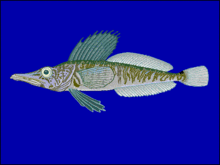Pagetopsis macropterus species of marine ray-finned fish belonging to the family Channichthyidae, the crocodile icefishes. This species is found in the Southern Ocean.
| Pagetopsis macropterus | |
|---|---|

| |
| P. macropterus | |
| Scientific classification | |
| Domain: | Eukaryota |
| Kingdom: | Animalia |
| Phylum: | Chordata |
| Class: | Actinopterygii |
| Order: | Perciformes |
| Family: | Channichthyidae |
| Genus: | Pagetopsis |
| Species: | P. macropterus
|
| Binomial name | |
| Pagetopsis macropterus (Boulenger, 1907)
| |
| Synonyms[1] | |
| |
Taxonomy
editPagetopsis macropterus was first formally described in 1907 as Champsocephalus macropterus by the Belgian-born British ichthyologist George Albert Boulenger with the type locality given as near Cape Armitage, Ross Island in Victoria Land.[2] When Charles Tate Regan described the genus Pagetopsis this was its type species by monotypy.[3] The specific name macropterus means "large finned" an allusion to the large dorsal and pelvic fins, especially those of juveniles.[4]
Description
editPagetopsis macropterus has around 15 narrow dark bars, lighter at the center, on its grayish green body and dark stripes on its cheeks but has a whitish ventral area. It grows to a maximum length of 33 cm (13 in) and lives at depths of 5 to 655 m (16 to 2,149 ft). The dorsal fins contain 12-15 spines and 27-32 soft rays while the anal fin has 24-27 soft rays. It has a large mouth with the maxilla reaching a level with the front third of the eye and this has two rows of conical teeth in each jaw. The caudal fin is almost truncate but can be rounded.[5]
Distribution, habitat and biology
editPagetopsis macropterus has a circum-Antarctic distribution on the continental shelf and the South Shetland Islands. It is a demersal fish which occurs at depths between 5 and 655 m (16 and 2,149 ft).[1] The defense posture, noted in a study in 1969, is opening the mouth wide, expanding the corner of the mouth and the opercula, erecting the dorsal fin, holding the flared pectoral fins at a right angle towards the body, and bending the body into a semicircle. The same study suggested that this behavior was developed to deter predators such as the Weddell seal (which preys heavily on this species).[5] Adults feed on fishes and krill. It is of no interest to commercial fisheries.[1]
References
edit- ^ a b c Froese, Rainer; Pauly, Daniel (eds.). "Pagetopsis macropterus". FishBase. June 2021 version.
- ^ Eschmeyer, William N.; Fricke, Ron & van der Laan, Richard (eds.). "Species in the genus Pagetopsis". Catalog of Fishes. California Academy of Sciences. Retrieved 26 October 2021.
- ^ Eschmeyer, William N.; Fricke, Ron & van der Laan, Richard (eds.). "Genera in the family Channichthyidae". Catalog of Fishes. California Academy of Sciences. Retrieved 26 October 2021.
- ^ Christopher Scharpf & Kenneth J. Lazara, eds. (12 April 2021). "Order Perciformes: Suborder Notothenoididei: Families Bovichtidae, Pseaudaphritidae, Elegopinidae, Nototheniidae, Harpagiferidae, Artedidraconidae, Bathydraconidae, Channichthyidae and Percophidae". The ETYFish Project Fish Name Etymology Database. Christopher Scharpf and Kenneth J. Lazara. Retrieved 26 October 2021.
- ^ a b T. Iwami and K-H Koch (1990). "Channicthyidae Icefishes". In O. Gon and P.C. Heemstra (eds.). Fishes of the Southern Ocean. South African Institute for Aquatic Biodiversity. ISBN 9780868102115.